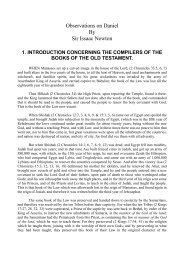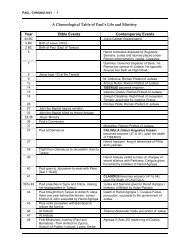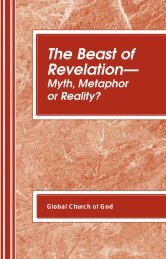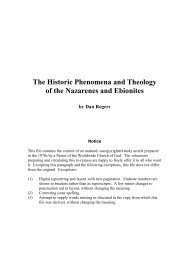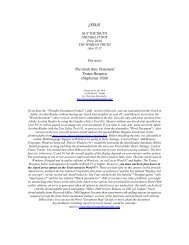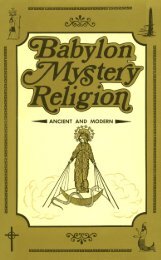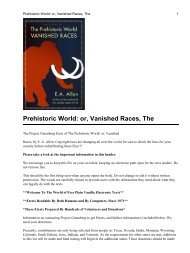by Percy E. Corbett - friendsofsabbath.org
by Percy E. Corbett - friendsofsabbath.org
by Percy E. Corbett - friendsofsabbath.org
Create successful ePaper yourself
Turn your PDF publications into a flip-book with our unique Google optimized e-Paper software.
5<br />
CHAPTER 1<br />
PRE-CHRISTIAN BRITAIN<br />
The idea that there was culture and erudite wisdom in Britain, thousands of years before the<br />
Christian era seems strange. But how many people have delved into the mysteries<br />
surrounding Glastonbury ? How many know that in the 1930's aerial photography revealed the<br />
existence of a pre-historic Zodiac circle modelled in the hills and landscape surrounding<br />
Glastonbury ? It is ten miles wide and thirty miles in circumference. Writing in "Country Life"<br />
just after World War II, Harold Steel, who had seen the gigantic effigies from the air, claimed to<br />
have calculated the possibility of such artificial constructions having assumed their symmetrical<br />
form <strong>by</strong> chance to be ten million to one.<br />
An extract from a booklet issued <strong>by</strong> the Avalon Research Foundation and published in "The<br />
Universal Voice" in 1965 reads:-<br />
"An examination of the evidence available indicates that astronomer architects from Sumeria<br />
gave their name to Somerset. Some five thousand years ago they came to design and<br />
construct these enormous effigies, portraying them in permanent form so that their<br />
symbolism might be preserved in perpetuity for posterity.”<br />
Does not the uniqueness of the existence of the Zodiac Circle in Somerset suggest that there<br />
is something unique about the Glastonbury area ? What guiding influence brought the<br />
Sumerians to Britain ? Was it the same influence which led the Three Wise men to Nazareth<br />
? These are fundamental questions which will be raised in different examples given in this<br />
booklet. Hence the title, "Why Britain ?"<br />
Let us jump a thousand years and note a statement <strong>by</strong> Ge<strong>org</strong>e Jowett (1) in "The Drama of the<br />
Lost Disciples." He writes:- The art of enamelling is early identified with Britain as the<br />
production of tin. The ancient Briton was the inventor of enamelling. He was so perfect in this<br />
craft that relics reposing in the British Museum and Glastonbury Museum such as the famous<br />
Glastonbury Bowl (over two thousand years old) and the beautiful Desborough Mirror are as<br />
perfect as the day they were made. They are magnificent examples, of "La Tene" art as the<br />
Celtic design is named, their geometric beauty and excellence being beyond the ability of<br />
modern craftsmen to duplicate.<br />
Confirmation of this technical ability of our ancestors is available from other sources. The<br />
famous British archaeologist, Sir Flinders Petrie, discovered in Old Gaza gold ornaments and<br />
enamelware of Celtic origin, dated 1500 B.C. and in reverse found Egyptian beads at<br />
Stonehenge. Jowett states that the tin that garnished the splendour of Solomon's Temple,<br />
1005 B.C., was mined and smelted into ingots at Cornwall and thence shipped <strong>by</strong> the<br />
Phoenicians to Palestine. Herodotus, circa 450 B.C., wrote of the British Isles and its people<br />
under the name of Cassitendes, remarking on their talent in the metal industry. Aristotle, 350<br />
B.C. was one of the first writers to name Britain the "Tin Islands." Julius Caesar following his<br />
campaign in Britain, 55 B.C., wrote with admiration of the culture of the British, their sterling<br />
(1) The Covenant Publishing Co. Ltd.



